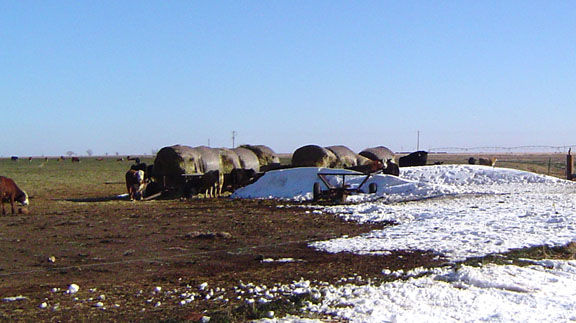Farm & Ranch
[AgriLife] Latent effects of blizzard a concern for cow-calf producers

Writer: Kay Ledbetter, 806-677-5608, [email protected]
Contact: Dr. Ted McCollum, 806-677-5600, [email protected]
AMARILLO – As the snow melts away from Winter Storm Goliath and cattle are gathered back into pens and pastures, cow-calf producers should continue to watch their animals for lingering after-effects, according to a Texas A&M AgriLife Extension Service specialist.
Cattle health following Winter Storm Goliath will continue to be a concern for producers. (Texas A&M AgriLife Extension Service photo by Dr. Ted McCollum)
“There is some potential for latent effects of the sustained low windchill temperatures during the recent blizzard conditions,” said Dr. Ted McCollum, AgriLife Extension beef cattle specialist in Amarillo.
McCollum said the bitter cold may have frozen the ears and tails of cattle and other animals, so partial loss may occur over the next few weeks.
“This may present some concern to the owners, but it is not a threat to the long-term well being of the cattle,” he said.
Another area of concern is the wind and low temperatures could have resulted in frozen teats and sensitive udders, McCollum said. The udders of cows nursing calves may be sensitive, which could affect milk consumption by the calf for a few days.
If the teats were impaired by frostbite, then there may be some mastitis and/or partial loss of udder function, he said, advising those tending to the cattle to watch the calves and check the udders.
“Also, cows that will be calving later this year could have been affected, but the effects may not be apparent until calving time and lactation,” McCollum said. “Again, observe the calves and the udders after calving.”
He said the extreme temperatures and frozen surfaces also could have impaired the prepuce and penis of the bulls as well as the scrotum and testicular function. It is recommended that bulls undergo a full breeding-soundness examination well in advance of the time they are expected to service cows.
Bulls that are with fall-calving cows now should be checked immediately, McCollum said. The breeding soundness exam will not only check for damage to the organs but also evaluate semen production and quality.
Fall-calving cows that are currently with bulls may have delayed pregnancy, he said. The extreme cold may have caused the cows to go into anestrus. Estrus activity will return to normal in a week to two weeks, barring any other insults.
“It is the producer’s decision, but extending the breeding season a couple of weeks might be a consideration,” McCollum said.
He advised that cow body condition continually be monitored.
“The extreme cold during the blizzard and the lack of significant warm-up since was a tax on body energy reserves,” McCollum said. “It may be necessary to increase supplemental feed for the remainder of the pregnancy period to offset the loss in body condition. And, winter is not over yet.”
-30-
Farm & Ranch
Hazards of Backyard Poultry

By Barry Whitworth, DVM
Having backyard poultry is a popular agriculture enterprise. According to the United States Department of Agriculture, 0.8 percent of all households in the United States have chickens. People keep chickens for a variety of reasons with table eggs being one of the more common reasons.
Unfortunately, some of these poultry producers are not aware of the hazards that come with keeping poultry because many times they carry pathogens but appear healthy.
Chickens are carriers of several zoonotic diseases. These are diseases that can be passed from animals to humans. According to a recent survey in Pennsylvania, a majority of backyard poultry producers were aware of the dangers of avian influenza. However, this study also revealed that far fewer producers were aware of the risk of possible exposure to Salmonella and Campylobacter.
The lack of knowledge about the hazards of raising poultry likely contributes to the continued issues of Salmonella outbreaks associated with backyard poultry. In 2023, the Centers for Disease Control and Prevention reported 1,072 illnesses of Salmonella linked to backyard poultry, and 272 of those patients required hospitalization. Oklahoma reported 43 individuals with the disease.
To read more, pick up a copy of the April issue of NTFR magazine. To subscribe by mail, call 940-872-5922.
Farm & Ranch
Ag Elsewhere: Wyoming

By Tressa Lawrence
Babies are tucked away in every nook and cranny. Many ranchers across Wyoming have baby animals popping up all over this time of year.
Farm & Ranch
Ag Elsewhere: Montana

By Lindsey Monk
Another load of grain in to keep feeding the calves until the green grass can really start popping.
-

 Country Lifestyles1 year ago
Country Lifestyles1 year agoScott & Stacey Schumacher: A Growth Mindset
-

 Equine7 months ago
Equine7 months agoThe Will to Win
-

 Country Lifestyles7 years ago
Country Lifestyles7 years agoStyle Your Profile – What your style cowboy hat says about you and new trends in 2017
-

 Country Lifestyles4 years ago
Country Lifestyles4 years agoAmber Crawford, Breakaway Roper
-

 HOME7 years ago
HOME7 years agoGrazing North Texas – Wilman Lovegrass
-

 Country Lifestyles7 years ago
Country Lifestyles7 years agoDecember 2016 Profile, Rusty Riddle – The Riddle Way
-

 Country Lifestyles8 years ago
Country Lifestyles8 years agoJune 2016 Profile – The man behind the mic: Bob Tallman
-

 Outdoor9 years ago
Outdoor9 years agoButtercup or Primrose?






